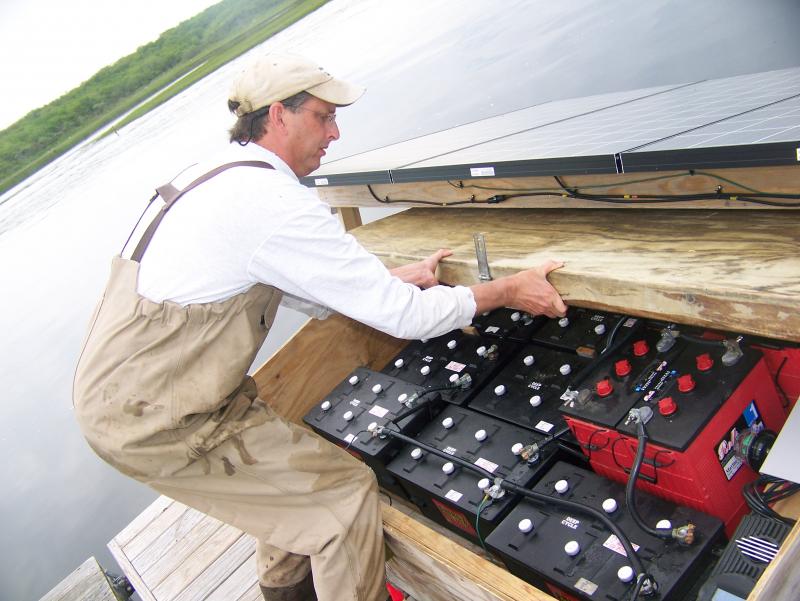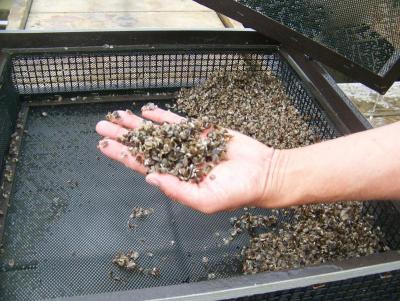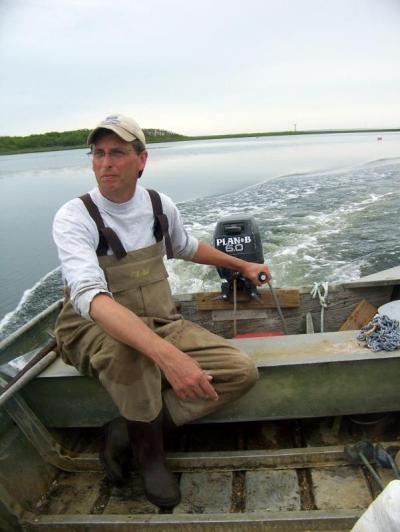Bright idea fuels oyster cultivation
When a shore-based oyster upweller at his family’s farm proved too expensive to operate, Bob Field took to the sea.
On a barge anchored in Hammond’s Cove six bright blue solar panels generate all of the electricity needed to feed shellfish in Field’s floating upwelling system. The system pumps water through a series of silos holding oyster “seed” – baby oysters measuring less than 2 millimeters across. The process gives the oysters plenty of fresh nutrients and helps them grow.
Field, who holds degrees in agriculture and civil engineering, built the barge with the help of the state’s Agricultural Energy Grant Program that paid $6,000 of the project’s $6,700 total cost.
The competitive grant program funds agricultural energy projects to promote clean energy solutions on Massachusetts’ farms. Up to $25,000 is available for projects classified as renewable energy or energy efficiency projects.
Field hand-built the barge based on a design from professor Dale Leavitt, of Roger Williams University in Rhode Island. It went into operation last June.
To reach the solar project, Field walks down a muddy, tree-lined path to reach the quiet cove where he cultivates the oysters. Once a day, he fires up the engine on a small boat and speeds to the barge to check battery levels, perform maintenance, and monitor oyster growth.
He said he wanted to grow oysters without spending the money needed to use a shore-based upweller.
“The cost would have been astronomical,” he said.
Part of the problem is the cove’s remoteness. Extending electricity to the shore to operate a land-based upweller would have been difficult, he said.
Instead, six 245-watt solar panels power a motor that constantly circulates water through four silos. The silos contain the young oysters, about 100,000 of them, and are screened to allow nutrient-rich water to wash through the system.
At night, nine 12-volt batteries keep the system running with excess energy stored from the panels throughout the day. The batteries, kept in a wooden compartment atop the barge, are designed to operate the system for three days without sunlight.
It takes 300 watts of electricity to run the system, Field said, adding he’s had no problem getting enough power.
Field placed the oyster seed in the system in mid-May. As the oysters grow they are eventually removed from the system and placed in baskets anchored nearby. Once the oysters reach market size Field sells the shellfish to wholesale buyers.
Considered a grower by the state, Field said he would need additional permitting to sell to retailers and restaurants. Increased awareness of raw bars is fueling oyster sales, he noted.
“The market is growing,” Field said. “There’s been a lot of interest from a consumer standpoint.”
The upwelling system is located behind Copper Beach Farm, where Field grew up. His parents still live there while Field has a home in Mattapoisett.
In the 1940s Field’s grandfather raised dairy cows. In the years since pigs, and occasionally a cow or two, could be found there. Oysters are the latest agricultural pursuit at the farm.

















